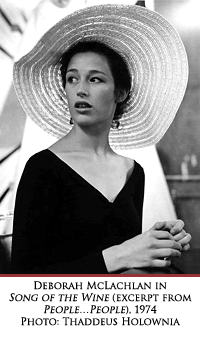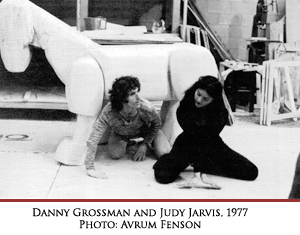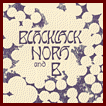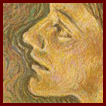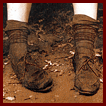 | ||||||||
When Judy met Larry she was 29, in full stride, able to cope with the demands of a gruelling teaching, travelling and rehearsal schedule. She was fired by the discoveries which she and Larry shared in their brief partnership. The yearning for companionship she expressed in her letters, the loneliness of always being the leader, was assuaged in this energizing meeting of like minds. In an initial four-month rehearsal period in 1971, they created four dances, Earth Move, Changes, Circus and And So On. They performed in Burlington in June; at the Ontario College of Education in July; at the University of Waterloo in August and at McMaster University in November. Larry and Judy were productive collaborators. They were founders and co-directors of the Performing Arts Circle, which lasted as long as their partnership. Andrea Smith was a frequent member of the Company, performing and working improvisationally with them. By 1973 their programme reflected both Judy's desire to appear as a soloist and the fruits of their time together. They performed at the Learning Resources Centre of Toronto in April, 1973. Later that spring they toured their programme Beings two nights at the National Arts Centre, at the Playhouse Theatre in Fredericton New Brunswick, in London England at The Place Theatre, and in West Berlin at the May Arts Festival at the Akademie der Kunst. Included on these programmes was their seminal work, Clouds. This dance for two faces continued to be a signature work in performances of Judy's subsequent companies.
This was a crucial time for Judy. If she had been able to sustain this working relationship, she might have found a way to strike more balanced relationships with co-workers in the future. But Larry was a little younger and committed to a spiritual path. Judy had already cast herself as the wiser, the more experienced, the leader yearning to be led. There is a sense that the kind of romantic attraction she often felt for her male partners was again frustrated. Larry married at the end of February 1973. He announced, apparently suddenly, that he would no longer be working with her. Judy, always an innocent in affairs of the heart, was wounded to the quick. For all her experiences and accomplishments, Judy's spiritual home remained with Mary Wigman. She returned to Europe every Christmas to visit her respected teacher. There was a close correspondence between the two for seven years. Mary Wigman's death in October of 1973 affected Judy very deeply. One of Judy's students at the time recalls going to her apartment shortly after Mary Wigman's death, finding her looking frighteningly distraught, her skin grey, her hair wild, her eyes sunken from sleeplessness. June-July 1973. I had danced at Berlin's Academy of the Arts in May and chose to spend some days with my dear friend and teacher. We talked of Nature, of Theatre, of the Opera, of people, of Dance, of books, of Religion, of little things, of big things, of past, present, future, of all that Life might offer. I miss you. You have helped give us a vision of beauty, of Joy, of the fulfillment of Life, of the greatness of Art. You lived, you suffered, but you endured, and loved. (Read Paper)
In 1974 Judy investigated being an actor, taking the role of Gabrielle in The Madwoman of Chaillot at the University of Toronto's University College. She worked with theatre directors Cheryl Cashman, Dennis Hayes and Frank Canino on a production of Shakespeare's The Tempest at Theatre Passe Muraille, taking the part of a sprite, as well as choreographing the production. She then began to carry this acting experience literally into her own living room. The lady has a different posture, a different way of moving, a different face, a different way of behaving than the normal way. When I came in my mother said, 'That's Nettie.' Somebody said, 'No, that's Mamie'. I hadn't meant that at all but they all started seeing older members of the family in this lady ... I kept her there for about half an hour ... just let her behave in the room. They started talking to her ... I think vocabulary is infinite. I'm not stuck for ideas, because I don't think them up, I let them happen.... That discovery was essential, I think, for the whole rest of my life, even as a human being -- to accept that things change and go on. (See and Hear Interview Excerpts) The "lady" she refers to metamorphosed into the character of Blacklack, one of the women in the Three Women section of Judy's dance, People...People. In recognition of her unique choreographic voice, Judy was named as the first modern dance recipient of the Chalmers Award for Choreography. It was during the 1974 Dance In Canada conference that she was presented with this prestigious prize for outstanding young Canadian choreographers.
The Company's first performances September 3-7 at Toronto Workshop Productions Theatre marked a strong change in the character of Judy's work. The programme included her solos Bird, Water, Street and Sun as well as the newly choreographed Just Before and In Between and People...People. Just Before and In Between was inspired by her thoughts at the time of her father's death and by the grief she still felt for Mary Wigman's death. Of People...People Judy wrote: "In Three Women they are three women I've seen within a mile radius of my apartment. It made us look at the dance in life. Each person has his own tempo. Each action has dance in it."
Judy's focus was always on the dance. She was the embodiment of the art. The associations she struck with managers never lasted. As she had no buffer, any attack on her work was a direct assault on the integrity of her personality and artistry. When cuts in grants came, they were wounds. When bad reviews started to come her way in the mid-70s, she was agonized. She felt isolated and vulnerable. Judy considered dance her home. People who worked with Judy often had difficulty matching her unbroken devotion. She would call rehearsals at odd hours and on weekends. Very rarely could you say I can't make rehearsal. If you didn't match her incredible love and dedication she would leave you out, ignore you, at least for a period of time. She could be brutal, and made no bones about it. I remember once she made me rehearse saying, 'Good Night' for three hours! She had liked it in improvisation so much, and wanted me to say it exactly that same way ...
Judy always had a galling time letting people go. She raged at some, moved by a profound sense of betrayal. For a leader who has invested of their vision and time, the loss of a dancer is a deep one. It is an irony of Judy's life that her aspiration to inspire and move people to dance was fully realized. But they didn't stay with her -- her flock dispersed to pursue their own dreams, influenced in turn by her fierce individuality. Judy ploughed on as the 70s progressed. In 1974 she choreographed Totem a production at the Ontario College of Art. She made dance appearances on Global and CBC television. Through 1974 and 1975 Judy's Company toured to Windsor, Montreal, Mississauga, Markham and Edmonton and also took part in the Women's Festival of the Arts in 1975. Through 1976 Judy continued to work at Waterloo. She taught and worked with the student company, doing remounts of Genesis, Ceremony and Tribal, while back in Toronto the Judy Jarvis Dance and Theatre Company presented a two-week season at St. Paul's Centre. She wanted to perform, and found the ratio of rehearsal to performance difficult. We did a two-week season at St. Paul's Church. Judy had guts. A two-week season in 1976! She would say "I want to get regular people in the seats and how can you do that if you run three nights? You only get the dance crowd." She was willing to do it at any cost, willing to go into debt to do a two-week season. In the summer of 1976 she performed at the Dance in Canada Conference in Halifax, taught at the University of Alberta and attended a course on creative dance for children with the renowned teacher and author, Joyce Boorman. Judy also taught at the Simon Fraser University summer dance intensive that year, as did dancer/choreographer Danny Grossman. She broke her left foot during the course, and was not in a positive emotional state, but persevered. She performed Clouds in her foot cast at the Cultural Olympics at Montreal's Centaur Theatre. The company also appeared that fall in the Toronto Dance Festival at the Toronto Workshop Productions Theatre. Despite these achievements, she felt isolated, hungry for creative collaboration. During this period she was taking class at the Toronto Dance Theatre, where Danny Grossman occasionally taught. Judy asked Grossman if he would dance Changes with her. Danny, declining to speak onstage as Changes required, suggested they collaborate on a new work. This was the beginning of Bella.
In this period, Judy's Company was manageably small and consistent. Judy trusted the Company members, the core dancers being Gina Lori Riley and Pam Grundy, and shared creation with relative ease for a time. The Company undertook a tour of the Algonquin Regional Library System, toured to Ottawa, dancing at Carleton University and the University of Ottawa, and took part in Choreochange at the studios of Groupe Nouvelle Aire in Montreal. Judy's students at the University of Waterloo developed Fiasko, which premiered in March, 1977. Judy adapted Fiasko later that year for her own Company when they danced at the University of Waterloo, The Toronto Free Theatre and 15 Dance Lab. Then in June 1977, Judy took her Company and her work to the Riverside Dance Festival in New York City. It was the culmination of her efforts from the previous five years. Bella was premiered there. Also in the searson were: Three Women, Song of The Wine, Clouds, Fiasko, Prophet, Flight and Just Before and In Between.
Later that summer, Jarvis and Grossman also presented Bella at the Winnipeg Dance in Canada Conference. The two performers, accompanied by selections from Puccini, danced, played and flirted on a huge flowered horse, combining gymnastics and lyricism, humour and eloquence and electrifying the audience ... the movement in it was so striking, so fully exploited that one is tempted to declare Jarvis and Grossman a national treasure. It was after the season at Riverside Church that Gina Lori Riley and Pam Grundy left the Company to pursue their own directions. In the years preceding the New York season, the Company maintained a small upstairs studio in Toronto's historic St. Paul's Church. There was a storage area filled with the Company's costumes and stage properties. In the summer of 1977 a small fire broke out, causing considerable smoke damage to the costumes and props. This was enough to give Judy a fresh taste of despair. (Next Page) ©2005, Dance Collection Danse | ||||||
"She went from hell to heaven every five minutes." Catherine Lee, Judy's student, | ||||||
"In Three Women they are three women I've seen within a mile radius of my apartment. It made us look at the dance in life. Each person has his own tempo. Each action has dance in it." Judy Jarvis | ||||||

 In New York, Judy met Larry McCullough, a young dancer who had trained at the Joffrey Ballet and also with Paul Sanasardo. Finding they shared ideas about dance, they began to work together in Toronto in 1971. This was to be a signal partnership for Judy.
In New York, Judy met Larry McCullough, a young dancer who had trained at the Joffrey Ballet and also with Paul Sanasardo. Finding they shared ideas about dance, they began to work together in Toronto in 1971. This was to be a signal partnership for Judy.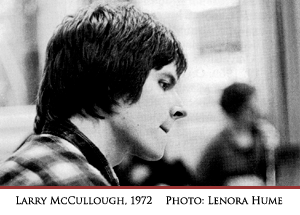
 In a life of artistic phases, Judy's next phase was a time of great change. Her trend toward character work, eventually toward the near-grotesque, was emerging. She was strengthened by her belief that the way for her was discovery through change.
In a life of artistic phases, Judy's next phase was a time of great change. Her trend toward character work, eventually toward the near-grotesque, was emerging. She was strengthened by her belief that the way for her was discovery through change. Judy gathered a nucleus of dancers and had already begun creating new works by the summer of 1974. Buoyed by her Jean A. Chalmers Award success she incorporated the Judy Jarvis Dance and Theatre Company later that same year. Along with Deborah McLachlan she included her long-standing student collaborators, Pam Grundy, and later Gina Lori Riley, as full Company members following their graduation from the University of Waterloo.
Judy gathered a nucleus of dancers and had already begun creating new works by the summer of 1974. Buoyed by her Jean A. Chalmers Award success she incorporated the Judy Jarvis Dance and Theatre Company later that same year. Along with Deborah McLachlan she included her long-standing student collaborators, Pam Grundy, and later Gina Lori Riley, as full Company members following their graduation from the University of Waterloo.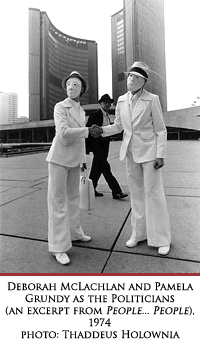 The Company first received assistance in the form of grants from the Ontario Arts Council in 1975. In 1976, the Canada Council began to support her Company's work. This lasted until 1981 when both agencies cut off her assistance. As well, the Company was supported by the Municipality of Metropolitan Toronto (1977-1982) and by the City of Toronto (1978-1983). She received sporadic assistance as an independent artist from the Canada Council and Ontario Arts Council from 1975 to 1983.
The Company first received assistance in the form of grants from the Ontario Arts Council in 1975. In 1976, the Canada Council began to support her Company's work. This lasted until 1981 when both agencies cut off her assistance. As well, the Company was supported by the Municipality of Metropolitan Toronto (1977-1982) and by the City of Toronto (1978-1983). She received sporadic assistance as an independent artist from the Canada Council and Ontario Arts Council from 1975 to 1983.